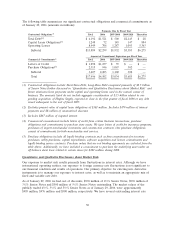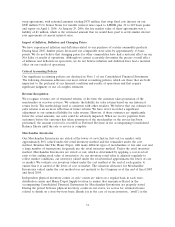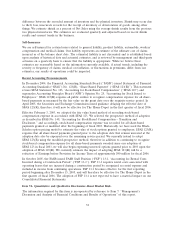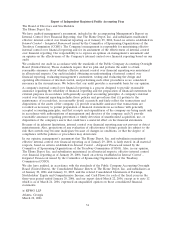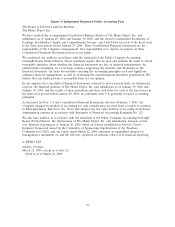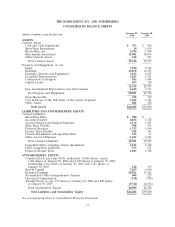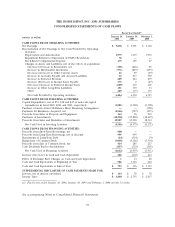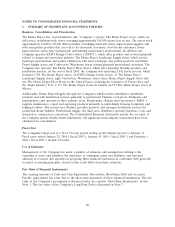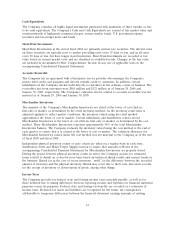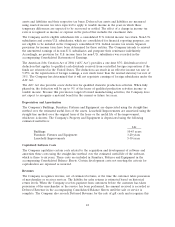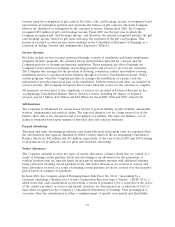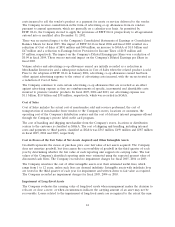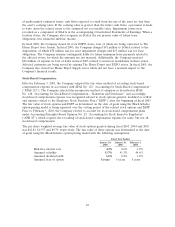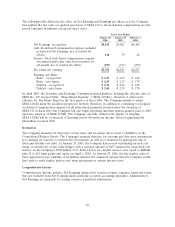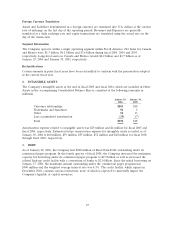Home Depot 2005 Annual Report Download - page 52
Download and view the complete annual report
Please find page 52 of the 2005 Home Depot annual report below. You can navigate through the pages in the report by either clicking on the pages listed below, or by using the keyword search tool below to find specific information within the annual report.NOTES TO CONSOLIDATED FINANCIAL STATEMENTS
1. SUMMARY OF SIGNIFICANT ACCOUNTING POLICIES
Business, Consolidation and Presentation
The Home Depot, Inc. and subsidiaries (the ‘‘Company’’) operate The Home Depot stores, which are
full-service, warehouse-style stores averaging approximately 105,000 square feet in size. The stores stock
approximately 35,000 to 45,000 different kinds of building materials, home improvement supplies and
lawn and garden products that are sold to do-it-yourself customers, do-it-for-me customers, home
improvement contractors, tradespeople and building maintenance professionals. In addition, the
Company operates EXPO Design Center stores (‘‘EXPO’’), which offer products and services primarily
related to design and renovation projects, The Home Depot Landscape Supply stores, which service
landscape professionals and garden enthusiasts with lawn, landscape and garden products and Home
Depot Supply stores and Contractors’ Warehouse stores serving primarily professional customers. The
Company also operates The Home Depot Floor Stores, which offer primarily flooring products and
installation services. At the end of fiscal 2005, the Company was operating 2,042 stores in total, which
included 1,793 The Home Depot stores, 34 EXPO Design Center stores, 11 The Home Depot
Landscape Supply stores, eight Contractors’ Warehouse stores, three Home Depot Supply stores and
two The Home Depot Floor Stores in the United States, including the territories of Puerto Rico and
the Virgin Islands (‘‘U.S.’’); 137 The Home Depot stores in Canada and 54 The Home Depot stores in
Mexico.
Additionally, Home Depot Supply, through the Company’s wholly-owned subsidiaries, distributes
products and sells installation services primarily to professional business contractors, businesses and
municipalities and operates in three primary areas. Maintenance, Repair and Operations (‘‘MRO’’)
supplies maintenance, repair and operating products primarily to multi-family housing, hospitality and
lodging facilities. The second area, Builder, provides products and arranges installation services for
production home builders. Professional Supply, the third area, distributes specialty hardware, tools and
materials to construction contractors. The Consolidated Financial Statements include the accounts of
the Company and its wholly-owned subsidiaries. All significant intercompany transactions have been
eliminated in consolidation.
Fiscal Year
The Company’s fiscal year is a 52 or 53-week period ending on the Sunday nearest to January 31.
Fiscal years ended January 29, 2006 (‘‘fiscal 2005’’), January 30, 2005 (‘‘fiscal 2004’’) and February 1,
2004 (‘‘fiscal 2003’’) include 52 weeks.
Use of Estimates
Management of the Company has made a number of estimates and assumptions relating to the
reporting of assets and liabilities, the disclosure of contingent assets and liabilities, and reported
amounts of revenues and expenses in preparing these financial statements in conformity with generally
accepted accounting principles. Actual results could differ from these estimates.
Fair Value of Financial Instruments
The carrying amounts of Cash and Cash Equivalents, Receivables, Short-Term Debt and Accounts
Payable approximate fair value due to the short-term maturities of these financial instruments. The fair
value of the Company’s investments is discussed under the caption ‘‘Short-Term Investments’’ in this
Note 1. The fair value of the Company’s Long-Term Debt is discussed in Note 3.
40


